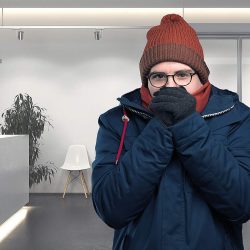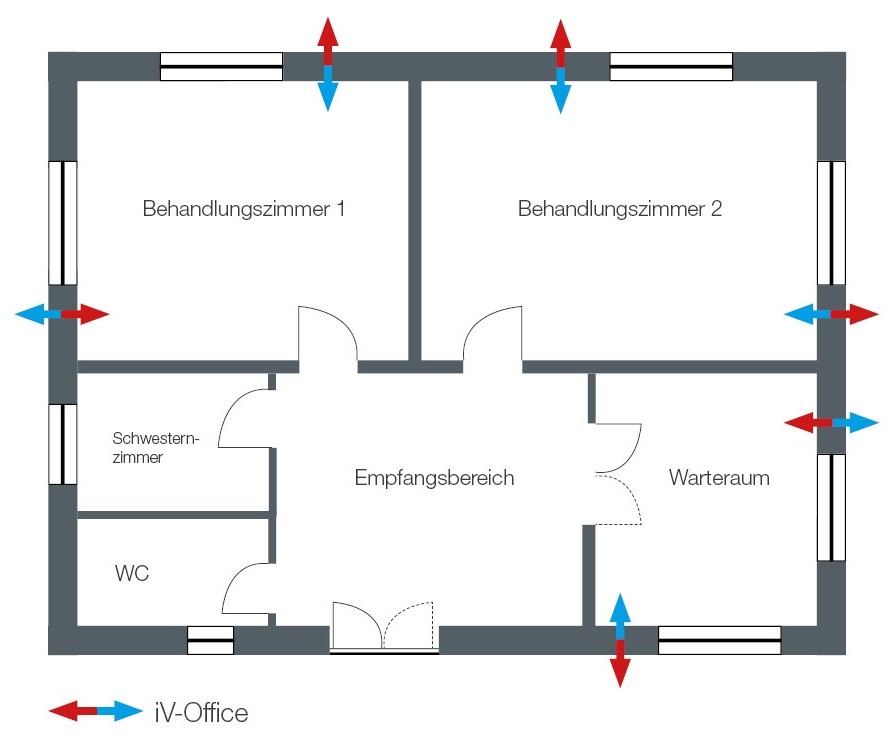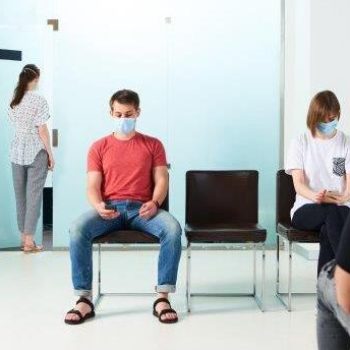Regular air exchange in the waiting roomHealthy air in the waiting room of a doctor's office
Keeping your distance, hand disinfection, face mask and ventilation are the order of the day. Especially in waiting rooms, where the most varied of people meet – with or without symptoms of illness, infectious diseases are transmitted very quickly via the insufficiently changed indoor air.
Contrary to common practice, tilted windows are not sufficient for an almost virus-free air in the waiting room. Regular, frequent intermittent ventilation should be the order of the day, but has the major disadvantage, especially in the cold season, that the waiting room cools down, customers or patients freeze and have to be re-heated at great expense. Controlled ventilation for waiting rooms within a doctor’s office can help.

- Regular air exchange
- Healthy feel-good climate
- Easy retrofitting
- Intuitive regulation of ventilation intensity
- Heat recovery through ceramic core
- Storage of heat guarantees air at a comfortable temperature
Planning examplefor ventilation in the doctor's office
Requirement:
ASR A3.6 and A3.7.
CO2 concentration below 1000 ppm
Volume flow: approx. 30 m³ / h per person
The ventilation requirements for ventilation in medical practices can be viewed similarly to those in offices and the design parameters of the Workplace Directive apply. This sets requirements for free ventilation via windows and for ventilation via mechanical ventilation systems in sections ASR A3.6 and A3.7.

The CO2 concentration is a recognized measure for evaluating indoor air quality. According to the Workplace Directive, this should not exceed 1,000 ppm. This can e.g. B. can be achieved by opening the window, then every 60 minutes, depending on the weather for 3-10 minutes, an intermittent ventilation should be carried out. Or the air exchange takes place through a ventilation system with a volume flow of approx. 30 m³ / h per person.
In addition to the removal of CO2, the mechanical ventilation in medical practices also prevents infections. Existing aerosols are transported to the outside via the devices and the fresh air supplied lowers the concentration of the aerosols in the room air.
Another possibility is the combination of mechanical ventilation and window ventilation. Through the use of efficient ventilation systems in waiting rooms and doctor’s offices, ventilation can take place entirely above them, or the number of window openings can be reduced to a minimum.
Treatment room
Treatment room 1 + 2 with 2 people each
30 m³ / h per person
Required outside air volume flow through the ventilation system = 60 m³ / h
The iV-Office is designed with 25 m³ / h per device in the treatment rooms, resulting in an outside air volume flow of 50 m³ / h with two devices in the room (one device pair).
This means that the people in the treatment rooms have 25 m³ / h of fresh air at their disposal through the ventilation.

Waiting room

Waiting room with an average of 5 people
30 m³ / h per person
Required outside air volume flow through the ventilation system = 150 m³ / h
In the waiting area, the devices are designed with 30 m³ / h per device, resulting in an outside air volume flow of 60 m³ / h with two devices in the room (one device pair).
This means that each person in the waiting room has 12 m³ / h of fresh air at their disposal.
Conclusion on ventilation in the doctor's office
The iV-Office achieves continuous basic ventilation within the specified sound emission requirements (here: 35 dB (A) in the treatment room and 40 dB (A) in the waiting room). The air exchange can be temporarily increased by the user to up to 90 m³ / h, or reduced temporarily in order to reduce noise emissions. In any case, the missing outside air volume flow can be reached through the windows. By fulfilling the requirements to 50%, in this example the required number of boost ventilation can be halved, so that boost ventilation every two hours is sufficient.
Your advantagesdecentralized ventilation in waiting rooms

- Up to 88% heat recovery
- Minimize cold drafts by ventilating the windows
- Low virus concentration due to the high proportion of fresh air
- Ventilation support up to 90 m³/h
- Easy retrofitting in the outer wall


